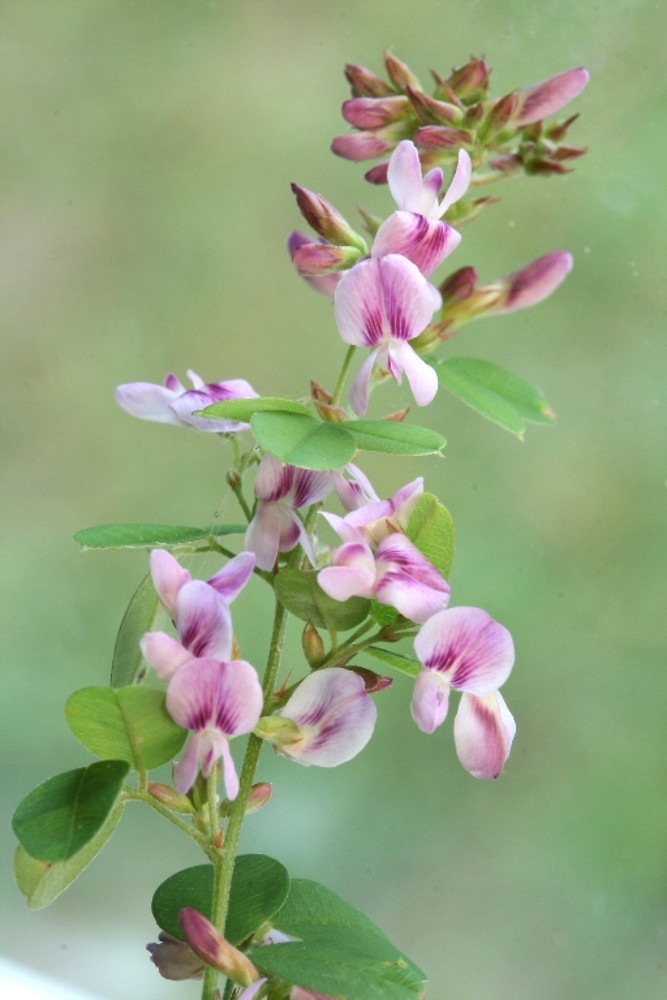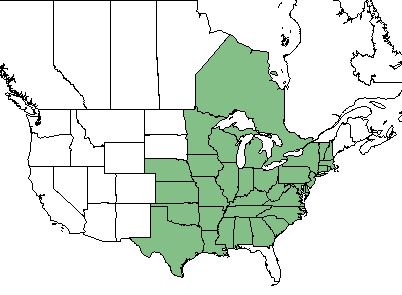Difference between revisions of "Lespedeza violacea"
(→Ecology) |
|||
| Line 32: | Line 32: | ||
==Ecology== | ==Ecology== | ||
===Habitat=== <!--Natural communities, human disturbed habitats, topography, hydrology, soils, light, fire regime requirements for removal of competition, etc.--> | ===Habitat=== <!--Natural communities, human disturbed habitats, topography, hydrology, soils, light, fire regime requirements for removal of competition, etc.--> | ||
| − | ''L. violacea'' proliferates in woodlands and woodland borders <ref name= "Weakley 2015"> Weakley, A. S. (2015). Flora of the Southern and Mid-Atlantic States. Chapel Hill, NC, University of North Carolina Herbarium. </ref>, and predominantly in lowland sites. <ref name "Towne 2008"> Towne, E. G. and K. E. Kemp (2008). "Long-term response patterns of tallgrass prairie to frequent summer burning." Rangeland Ecology & Management 61: 509-520. </ref> | + | ''L. violacea'' proliferates in woodlands and woodland borders <ref name= "Weakley 2015"> Weakley, A. S. (2015). Flora of the Southern and Mid-Atlantic States. Chapel Hill, NC, University of North Carolina Herbarium. </ref>, and predominantly in lowland sites. <ref name "Towne 2008"> Towne, E. G. and K. E. Kemp (2008). "Long-term response patterns of tallgrass prairie to frequent summer burning." Rangeland Ecology & Management 61: 509-520. </ref> Specimens have been collected from limestone outcrop, second growth of black oak area, cedar bluff woods, sandy soil of upland oak-hickory forest, open oak woods, sandstone quarry, shaded roadside, river bank, old field scattered with trees, bluff above floodplain, burned over pine region with clay soil, and bottomland hardwood. <ref name = "FSU herbarium"> URL: http://herbarium.bio.fsu.edu. Last accessed: June 2018. Collectors: R.K. Godfrey, R. komarek, Robert Thorne, G.W. Parmalee, Andre Clewell, Paul Redfearn, H. A. Wahl, Norlan Henderson, George Jones, Norlan Henderson, Sidney McDaniel, Dick Houk, V. Muehlenbach, Sidney McDaniel, Norman E. Hill. States and counties: Florida (Leon) Georgia (Grady) Virginia (Giles) Michigan (Jackson) Indiana (Brown, Monroe, Martin) Missouri (Johnson, Osage, Platte, Jackson, Barton, St. Clair) Mississippi (Chickasaw, Tallahatchie, Holmes, Madison) Alabama (Cleburne, Calhoun)</ref> |
===Phenology=== <!--Timing off flowering, fruiting, seed dispersal, and environmental triggers. Cite PanFlora website if appropriate: http://www.gilnelson.com/PanFlora/ --> | ===Phenology=== <!--Timing off flowering, fruiting, seed dispersal, and environmental triggers. Cite PanFlora website if appropriate: http://www.gilnelson.com/PanFlora/ --> | ||
Revision as of 14:41, 29 June 2018
Common name: violet lespedeza [1], wand lespedeza [2]
| Lespedeza violacea | |
|---|---|

| |
| Photo by Arieh Tal of Botphoto.com | |
| Scientific classification | |
| Kingdom: | Plantae |
| Division: | Magnoliophyta - Flowering plants |
| Class: | Magnoliopsida - Dicots |
| Order: | Fabales |
| Family: | Fabaceae |
| Genus: | Lespedeza |
| Species: | L. violacea |
| Binomial name | |
| Lespedeza violacea L. | |

| |
| Natural range of Lespedeza violacea from USDA NRCS Plants Database. | |
Contents
Taxonomic Notes
Synonyms: L. intermedia (S. Watson) Britton
Varieties: Lespedeza virgata (Thunberg) A.P. de Candolle
Description
L. violacea is a perennial forb/herb of the Fabaceae family native to North America and Canada. [1]
Distribution
L. violacea is found in the eastern half of the United States excluding Florida, as well as the Ontario region of Canada. [1]
Ecology
Habitat
L. violacea proliferates in woodlands and woodland borders [2], and predominantly in lowland sites. [3] Specimens have been collected from limestone outcrop, second growth of black oak area, cedar bluff woods, sandy soil of upland oak-hickory forest, open oak woods, sandstone quarry, shaded roadside, river bank, old field scattered with trees, bluff above floodplain, burned over pine region with clay soil, and bottomland hardwood. [4]
Phenology
L. violacea flowers in September. [5]
Conservation and Management
L. violacea is listed as rare by the New York Department of Environmental Conservation Division of Land and Forests, and as threatened by the Vermont Department of Fish and Wildlife Nongame and Natural Heritage Program. [1]
Cultivation and restoration
Photo Gallery
References and notes
- ↑ 1.0 1.1 1.2 1.3 USDA Plant Database https://plants.usda.gov/core/profile?symbol=LEVI6
- ↑ 2.0 2.1 Weakley, A. S. (2015). Flora of the Southern and Mid-Atlantic States. Chapel Hill, NC, University of North Carolina Herbarium.
- ↑ Towne, E. G. and K. E. Kemp (2008). "Long-term response patterns of tallgrass prairie to frequent summer burning." Rangeland Ecology & Management 61: 509-520.
- ↑ URL: http://herbarium.bio.fsu.edu. Last accessed: June 2018. Collectors: R.K. Godfrey, R. komarek, Robert Thorne, G.W. Parmalee, Andre Clewell, Paul Redfearn, H. A. Wahl, Norlan Henderson, George Jones, Norlan Henderson, Sidney McDaniel, Dick Houk, V. Muehlenbach, Sidney McDaniel, Norman E. Hill. States and counties: Florida (Leon) Georgia (Grady) Virginia (Giles) Michigan (Jackson) Indiana (Brown, Monroe, Martin) Missouri (Johnson, Osage, Platte, Jackson, Barton, St. Clair) Mississippi (Chickasaw, Tallahatchie, Holmes, Madison) Alabama (Cleburne, Calhoun)
- ↑ PanFlora Author: Gil Nelson URL: http://www.gilnelson.com/PanFlora/ Date Accessed: 5/24/18